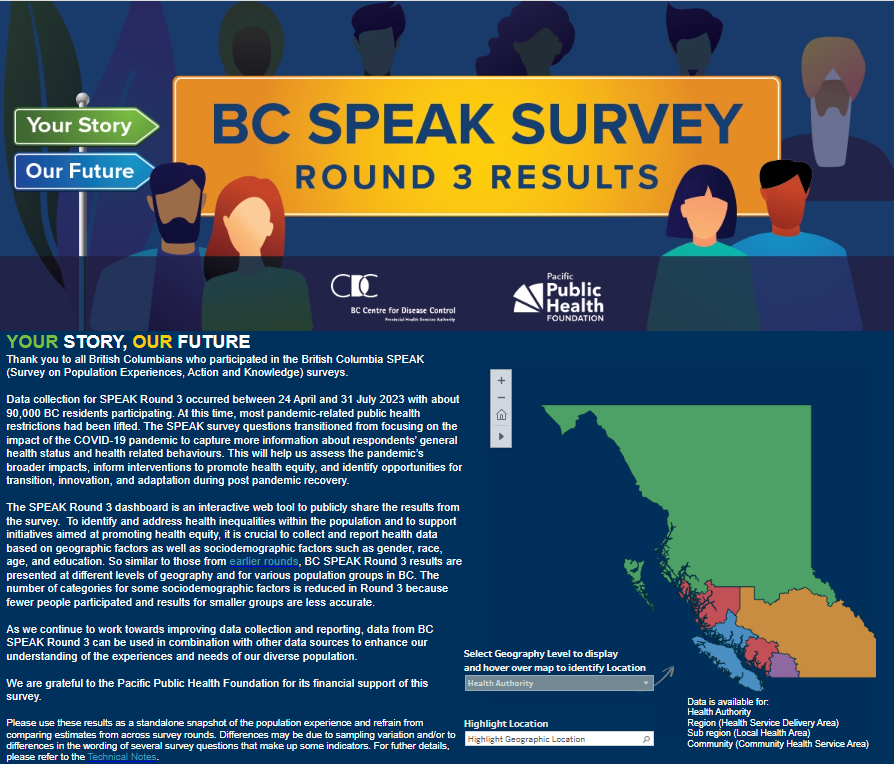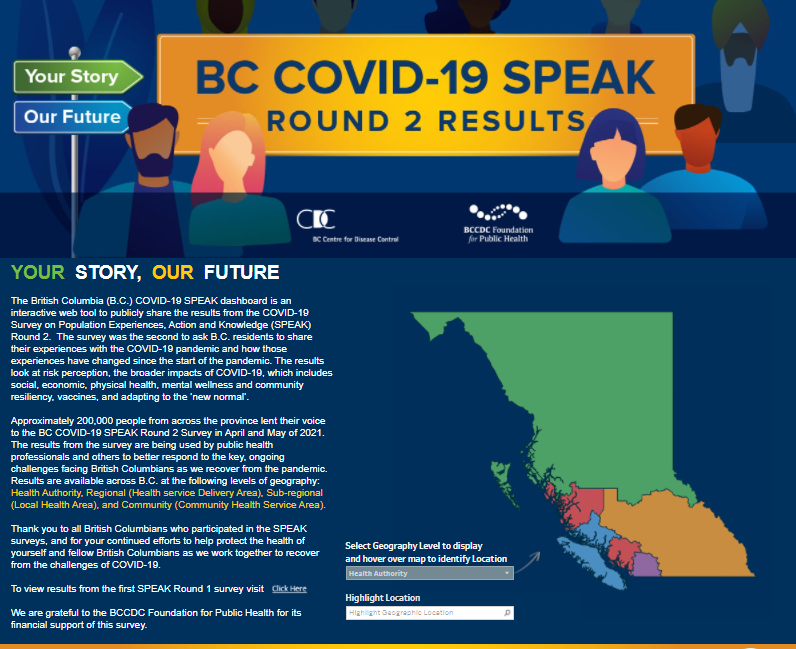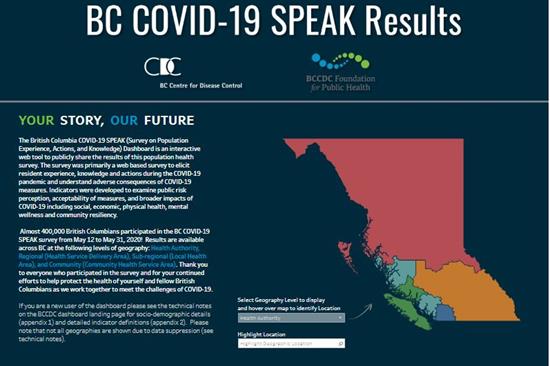Explore the results from the British Columbia (BC) Survey on Population Experiences, Action, and Knowledge (SPEAK).
The British Columbia (B.C.) Survey on Population Experiences, Action, and Knowledge (SPEAK) is a web-based population health survey designed to learn about BC residents’ experience, knowledge, and actions at different phases of the COVID-19 pandemic, and understand the impacts of the pandemic at local, regional, and provincial levels.
The results look at risk perception and the broader impacts of COVID-19, which include social, economic, physical health, mental wellness, and community resiliency. There have been three rounds of BC SPEAK.
The SPEAK dashboards are interactive web tools to publicly share the results from the surveys. Results are available across B.C. and at regional levels.

See the dashboard
Data collection for SPEAK Round 3 occurred between April 24 and July 31, 2023 with about 90,000 BC residents participating. At this time, most pandemic-related public health restrictions had been lifted. The survey questions transitioned from focusing on the impact of the COVID-19 pandemic to capturing information about respondents’ general health status and health-related behaviours. Public health professionals and others are using the results to identify sustainable opportunities for transition, innovation, and adaptation during post-pandemic recovery.
 See the dashboard
See the dashboard
Approximately 200,000 people from across the province lent their voice to the second BC COVID-19 SPEAK survey in April and May 2021. The survey was held at a time when many British Columbians became eligible to receive their first dose of the COVID-19 vaccine and during the third wave of COVID-19 in B.C.
The survey asked about the ongoing challenges facing British Columbians and about our future. Public health professionals and others are using the results to inform BC’s recovery from the pandemic.
 See the dashboard
See the dashboard
Almost 400,000 British Columbians participated in the first survey, held in May 2020. The survey asked BC residents about their experience, knowledge and actions early in the COVID-19 pandemic. The results looked at risk perception and the impact of COVID-19 during the first months of the pandemic.
Public health, government, and community stakeholders used the results to inform public health guidance such as the return to in-class learning for Kindergarten to grade 12 students.
Thank you to all British Columbians who participated in the SPEAK surveys.
We are grateful to the
Pacific Public Health Foundation for the financial support of this survey and dashboard.
The dashboards are built on the Tableau platform. You will need to use one of the follow web browsers:
- Chrome on Windows, Mac, and Android
- Microsoft Edge on Windows
- Mozilla Firefox & Firefox ESR on Windows and Mac
- Apple Safari on Mac and iOS 11.3 or later
The data are used by public health, government and community stakeholders to
inform the prioritization and targeting of public health interventions, practices, and policies as we move toward recovery in the short and long term.
Some examples include:
- monitoring impacts of the pandemic;
prioritizing support and initiatives for population segments more disproportionally affected, for example households with school-age children and young adults;
increasing support and initiatives to improve mental health and societal resiliency;
informing climate change adaptation and preparedness including to extreme weather.
In accordance with Indigenous data governance practices in B.C., data from Indigenous respondents is provided to the First Nations Health Authority and Metis Nation B.C. to determine how best to use the data in planning and engaging Indigenous communities across the province.
All voluntary surveys include some selection bias. This means some populations or groups are more likely to take part than others. We adjust the results as best we can to be more representative. This includes outreach and post-collection weighting. Weighting means the answers of groups who participated less are ‘amplified’. Moreover, since the estimates obtained from the survey are based on a sample, there is variability in the values obtained in the sense that a different sample could result in different results. The amount of variability increases as the sample size decreases such as for smaller geographic areas. Please see the technical notes for the survey round of interest for more details.
Please see the technical notes on this page for more information. Appendix 1 includes indicator definitions, methods and analysis, data suppression, survey limitations and socio-demographic details. Appendix 2 includes detailed indicator definitions. Not all areas are shown in the dashboard due to data suppression (see technical notes for the survey round of interest).
This is due to data suppression in several communities across B.C. Please see the technical notes for the survey round of interest for more details.
There is a large dataset behind the dashboard and it takes a while to run.
Region, sub-region, and community borders do not necessarily follow municipal boundaries. For in-depth geographic comparisons please use the downloadable dataset for the survey round of interest.
Send your questions to
admininfo@bccdc.ca
Safeguards are in place to ensure your privacy. Data collected in the BC SPEAK surveys follows strict privacy practices under the B.C. Freedom of Information and Protection of Privacy Act. The act governs how your information is collected, who sees it and how the information is used.
